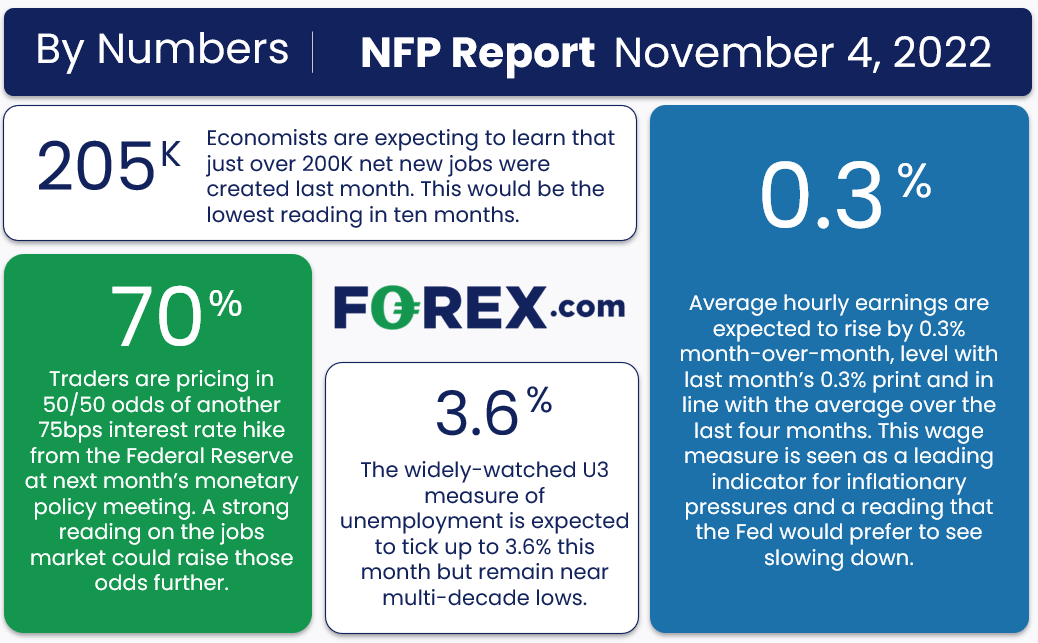Following Wednesday’s FOMC meeting, it's clear that Federal Reserve Chair, Jerome Powell and company are still far more concerned about the “price stability” half of their dual mandate than the “full employment” half. Nonetheless, the central bank remains data dependent, so this month’s jobs report will play into the central bank’s interest rate decision at the upcoming December meeting.
With two nonfarm payroll (NFP) reports and another CPI reading scheduled before the Fed’s next interest rate decision in mid-December, it’s not surprising that traders are uncertain about what the central bank will do. According to the CME’s FedWatch tool, traders are split 50/50 between expecting another 75bps rate hike and a downshift to 50bps, so we’re likely to see some market volatility regardless of how this month’s jobs report prints. For the October NFP report, consensus expectations are for 205,000 net new jobs and average hourly earnings projected to rise by 0.3% month-over-month:

Source: StoneX
Are the expectations for NFP justified? We dive into the key leading indicators for Friday’s critical jobs report below!
As regular readers know, we focus on four historically reliable leading indicators to help handicap each month’s NFP report:
- The ISM Services PMI Employment component fell to 49.1, down from last month’s 53.0 reading and back in contractionary territory.
- The ISM Manufacturing PMI Employment component rose to 50.0, up from last month’s 48.7 reading.
- The newly revised ADP Employment report printed at 239,000, up from last month’s downwardly revised 192K print.
- Finally, the 4-week moving average of initial unemployment claims ticked up to 219,000, up slightly from last month’s 207K reading but still near multi-decade lows.
As a reminder, the state of the US labor market remains more uncertain and volatile than usual as it emerges from the unprecedented disruption of the COVID pandemic. That said, weighing the data and our internal models, the leading indicators point to a slightly stronger-than-expected reading in this month’s NFP report, with headline job growth potentially coming in somewhere in the 175-275,000 range, albeit with a bigger band of uncertainty than ever given the current global backdrop.
Regardless, the month-to-month fluctuations in this report are notoriously difficult to predict, so we wouldn’t put too much stock into any forecasts (including ours). As always, the other aspects of the release, prominently including the closely-watched average hourly earnings figure which came in at 0.3% month-on-month in the most recent NFP report.
Potential NFP market reaction

The US dollar index has spent the last month consolidating between 109.50 and 113.50 as traders evaluate the state of the global economy and whether the Federal Reserve will be more aggressive in raising interest rates than its major rivals. The consolidative price action doesn’t leave a strong technical bias for the world’s reserve currency, so if you’re trading the NFP report, it will be crucial to pick the right pair.
As for potential trade setups, readers may want to consider sell opportunities on EUR/USD on a strong NFP reading. The world’s most-widely traded currency pair has turned lower after a false break above parity (1.00) last week and broken a near-term bullish trend line, opening the door for more downside toward the October lows in the mid-0.9600s or even the two-decade lows in the mid-0.9500s if the US labor market surprises to the upside.
On the other hand, a soft jobs report could present a short-term sell opportunity in USD/CAD. While the broader trend favors the greenback, USD/CAD is currently holding below the September and October highs and could form a potential head-and-shoulders top pattern if it rolls over on the back of a slowing jobs report in the US.
